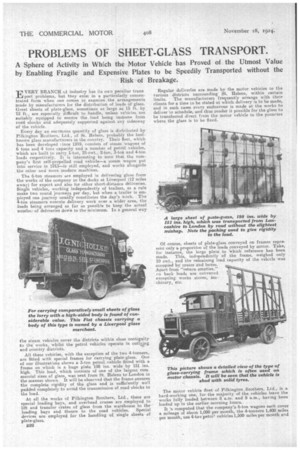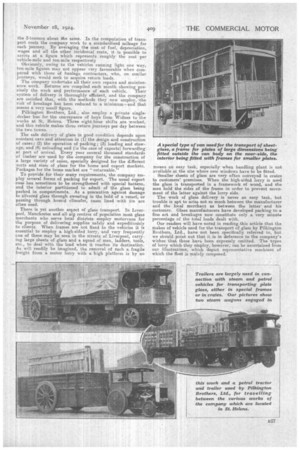PROBLEMS OF SHEET-GLASS TRANSPORT.
Page 10

Page 11

If you've noticed an error in this article please click here to report it so we can fix it.
A Sphere of Activity in Which the Motor Vehicle has Proved of the Utmost Value by Enabling Fragile and Expensive Plates to be Speedily Transported without the Risk of Breakage.
EVERY BRANCH cd industry has its own peculiar trans port problems, but they exist in a particularly concentrated form when one comes to examine the arrangements made by Manufacturers for the distribution of loads of glass. Great sleets of plate-glass, sometimes as large as 15 ft. by 12 ft., are especially difficult to handle, unless vehicles are suitably equipped to ensure the load being immune from roan shocks and adequately supported against any sidesway of the vehicle,
Every day an encrmous quantity of glass is distributed by Pilkington Brothers, Ltd., of St. Helens, probably the bestknown glass manufacturers in the country. Their ?feet, which has been developed F incke 1919, consists of steam wagons of 6 tons and 4 tons capacity and a number of petrol vehicles, -which are built to carry 1-ton, 25-cwt., 2-ton, 3-ton and 4-ton loads respectively. It is interesting to note that the company's first self-propelled road vehicle—a steam wagon put into service in 1913—is still employed, and works alongside the other and more modern machines.
The 6-ton steamers are employed in delivering glass from the works of the company to the docks at Liverpool (12 miles away) for export and also tor other short-distance deliveries. Single vehicles, working independently of trailers, as a rule make two round journeys per day, but when a trailer is employed one journey usually constitutes the day's Work. The 4-ton steamers execute delivery work over a wider area, the loads being arranged so far as possible to keep the actual numbee of deliveries down to the minimum. In a general way the steam vehicles cover the districts within close contiguity to the works, whilst the petrol vehicles operate in outlying and country districts.
All these vehicles, with the exception of the two 4-tonners, are fitted with special frames for carrying plate-glass. One of our illustrations shows a3-ton petrol vehicle fitted with a frame on which is a huge plate 198 ins, wide by 151 ins. high. This load, which consists of one of the largest coramercial sizes of glass, was sent from St. Helens to London in the manner shown. It will be observed that the frame ensures the complete rigidity of the glass and is sufficiently well padded completely to avoid the transmission of road shocks to the load.
At all the works of Pilkington Brothers, Ltd., there are special loading bays, and overhead cranes are employed to lift and transfer crates of glass from the warehouse to the loading bays and thence to the road vehicles. Special devices are employed for the handling of single sheets of plate-glass.
B26 Regular deliveries are made by the motor vehicles to the various districts surrounding St. Helens, within certain
limits. The manufacturers frequently arrange with their cheats for a time to be stated at which delivery is to be made, and in such cases every endeavour is made at the works to deliver to schedule, and thus render it possible for the glass to be transferred direct from the motor vehicle to the premises where the glass is to be fixed.
Of -course, sheets of plate-glass conveyed on frames represent only a proportion of the loads conveyed by motor. Take,
• for instauce, the large plate to Which reference has been made. This, independently of the frame, weighed only 10 cwt. and the reinaining load capacity of the vehicle was Occupied by crates mid boxes. Apart from ''return empties," Yo back loads are conveyed excepting works stores, ma.chinery, etc.
The motor vehicle fleet of Pilkington Brothers, Ltd., is a hard-working one, for the majority of the vehicles leave the works fully loaded between 8 a.m. and 9 a.m., having been loaded up in the earlier morning hours. It is computed that the company's 6-ton wagons each cover a mileage of about 1,000 per month, the 4-tonners 1,400 miles per month, Lae 4-ton petrc' vehicles 1,500 miles per month and the 3-tonners about the same. In the computation of transport costs the company work to a standardized mileage for each journey. By averaging the cost of fuel, depreciation, wages and all the other incidental costs, it is possible to arrive at a figure which represents roughly the cost per vehicle-mile and ton-mile respectively Obviously, owing to the vehicles running light one way, ton-mile figures may not appear very favourable when corn.pared with those of haulage contractors, who, on similar Journeys, would seek to acquire return loads.
The company undertake all their own repairs and maintenance work. Returns are compiled each month showing -are
cisely the work and performance of each vehicle. rieir system of delivery is thoroughly efficient, and the company are satisfied that, with the methods they now employ, the risk of breakage has been reduced to a minimum—and that means a very small figure.
Pilkington Brothers, Ltd., also employ a private singledecker bus for the conveyance of boys from Widnes to the works at St. Helens. Three eight-hour shifts are worked, and this vehicle makes three return journeys per day between the two towns.
The safe delivery of glass in good condition depends upon constant care and attenteen in (1) the design and construction of cases; (2) the operation of packing; (3) loading and stowage, and (4) unloading and (in the case of exports) forwarding, at port of arrival. Every year several thousand standards of timber are used by the company for the construction of a large variety of cases, specially designed for the different sorts and sizes of glass for the home and export markets. Packages for the home market are "returnable."
To provide for their many requirements, the company employ several forms of packing for expert. The usual export case has sometimes to be strengthened with special battens, and the interior partitioned to admit of the glass being packed in compartments. As a peecaution against damage to silvered glass through sweating in the hold of a vessel, or passing through .humid climates, cases lined with tin are often used.
There is yet another aspect of glass transport. In Liverpool, Manchester and all mg centres of population most glass merchants who serve local districts employ motorvans for the _purpose of delivering supplies safely and expeditiously to clients. When frames are not fixed to the vehicles it is essential to employ a high-sided lorry, and very frequently one of these may be seen in the streets of Liverpool, carrying large sheets of glass and a squad of men, ladders, tools, etc., to deal with the load when it reaches its destination. As will readily he imagined, the removal of such a fragile freight from a motor lorry with a high platform is by no means an easy task, especially when handling plant is not available at the site where new windows have to he fitted.
Smaller sheets of glass are very often conveyed in crates to customers' premises. When the high-sided lorry is used the glass is transported in a framework of wood, and the men hold the sides of the frame in order to prevent movement of the latter against the lorry side.
The work of glass delivery is never an easy task, but trouble is apt to arise not so much between the manufacturer and the local merchant as between the latter and his customer. Glass manufacturers have developed packing to a fine art and breakages now constitute only a very minute percentage of the total loads dealt with. Our readers will have noted in reading this article that the makes of vehicle used for the transport of glass by Pilkington Brothers Ltd., have not been specifically referred to, but we should.point out that it is in deference to the company's wishes that these have been expressly omitted. The types of lorry which they employ, however, can be ascertained from our illustrations, which depict representative machines of which the fleet is maiely composed.
































